Civil Engineering Technology Report: Industrial Complex, HNC/HND
VerifiedAdded on 2023/01/07
|13
|4217
|75
Report
AI Summary
This report provides a detailed analysis of civil engineering technology, focusing on the design and construction of an industrial complex. The report begins with an introduction that outlines the project's scope, including the development of ten industrial buildings near Heathrow Airport. Task 1 explore...
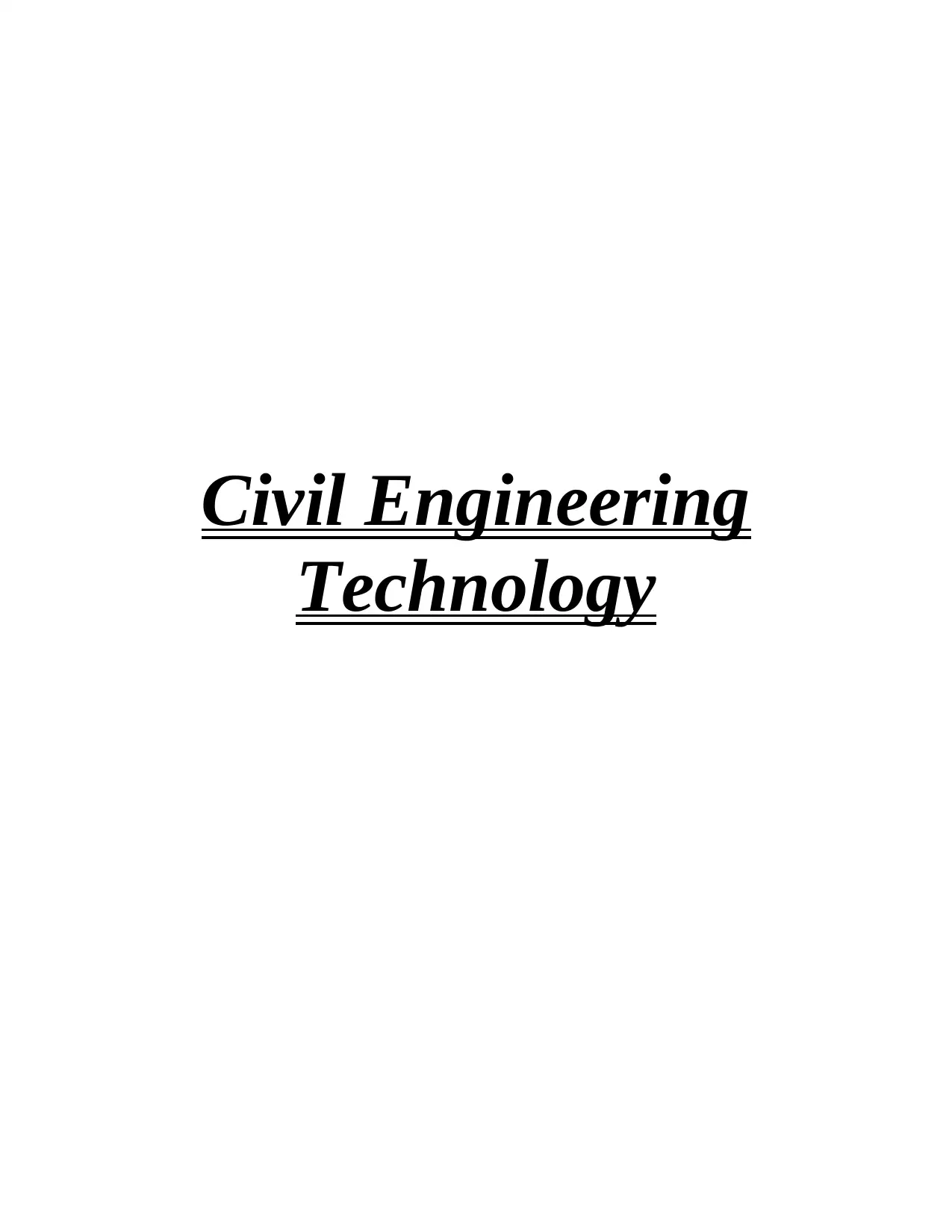
Civil Engineering
Technology
Technology
Paraphrase This Document
Need a fresh take? Get an instant paraphrase of this document with our AI Paraphraser
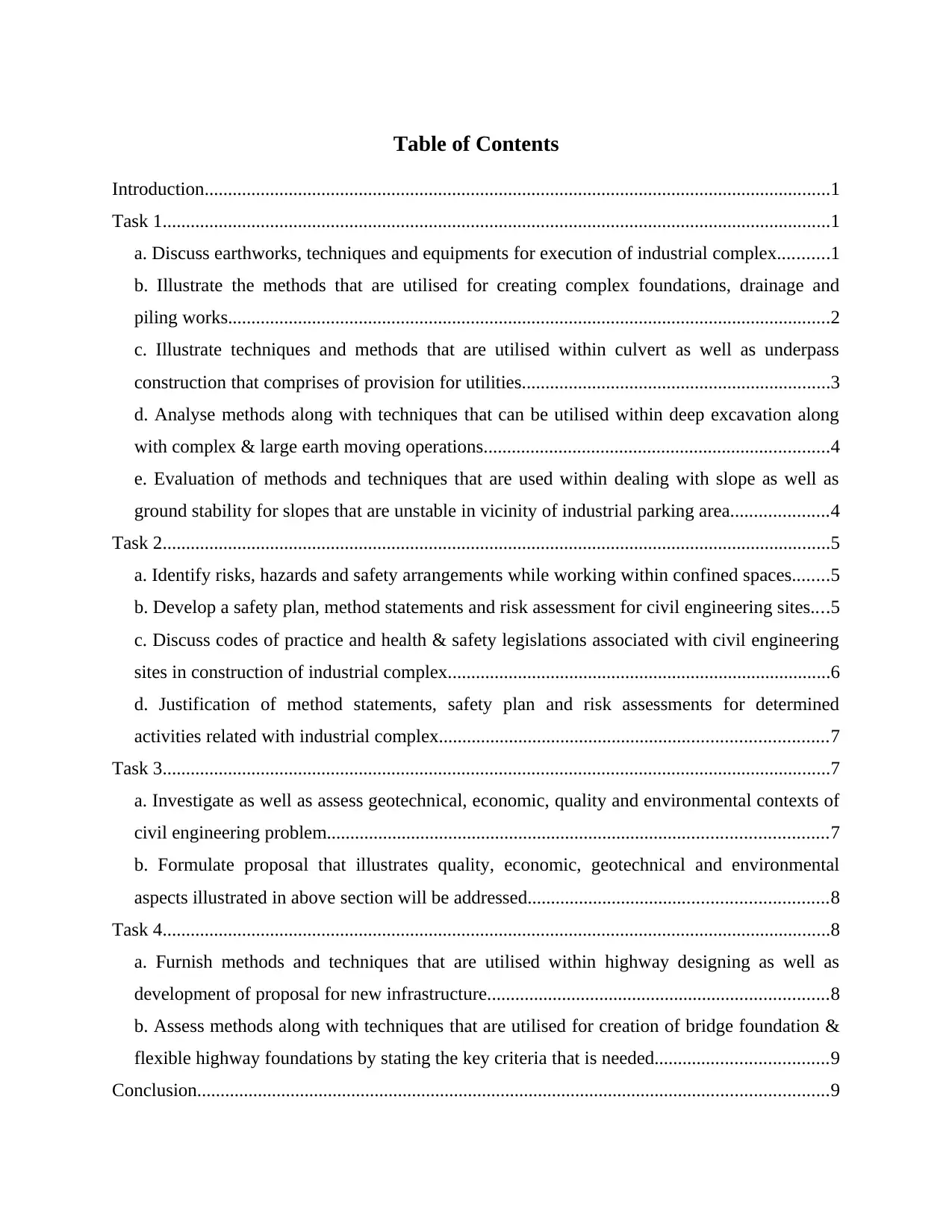
Table of Contents
Introduction......................................................................................................................................1
Task 1...............................................................................................................................................1
a. Discuss earthworks, techniques and equipments for execution of industrial complex...........1
b. Illustrate the methods that are utilised for creating complex foundations, drainage and
piling works.................................................................................................................................2
c. Illustrate techniques and methods that are utilised within culvert as well as underpass
construction that comprises of provision for utilities..................................................................3
d. Analyse methods along with techniques that can be utilised within deep excavation along
with complex & large earth moving operations..........................................................................4
e. Evaluation of methods and techniques that are used within dealing with slope as well as
ground stability for slopes that are unstable in vicinity of industrial parking area.....................4
Task 2...............................................................................................................................................5
a. Identify risks, hazards and safety arrangements while working within confined spaces........5
b. Develop a safety plan, method statements and risk assessment for civil engineering sites....5
c. Discuss codes of practice and health & safety legislations associated with civil engineering
sites in construction of industrial complex..................................................................................6
d. Justification of method statements, safety plan and risk assessments for determined
activities related with industrial complex...................................................................................7
Task 3...............................................................................................................................................7
a. Investigate as well as assess geotechnical, economic, quality and environmental contexts of
civil engineering problem...........................................................................................................7
b. Formulate proposal that illustrates quality, economic, geotechnical and environmental
aspects illustrated in above section will be addressed................................................................8
Task 4...............................................................................................................................................8
a. Furnish methods and techniques that are utilised within highway designing as well as
development of proposal for new infrastructure.........................................................................8
b. Assess methods along with techniques that are utilised for creation of bridge foundation &
flexible highway foundations by stating the key criteria that is needed.....................................9
Conclusion.......................................................................................................................................9
Introduction......................................................................................................................................1
Task 1...............................................................................................................................................1
a. Discuss earthworks, techniques and equipments for execution of industrial complex...........1
b. Illustrate the methods that are utilised for creating complex foundations, drainage and
piling works.................................................................................................................................2
c. Illustrate techniques and methods that are utilised within culvert as well as underpass
construction that comprises of provision for utilities..................................................................3
d. Analyse methods along with techniques that can be utilised within deep excavation along
with complex & large earth moving operations..........................................................................4
e. Evaluation of methods and techniques that are used within dealing with slope as well as
ground stability for slopes that are unstable in vicinity of industrial parking area.....................4
Task 2...............................................................................................................................................5
a. Identify risks, hazards and safety arrangements while working within confined spaces........5
b. Develop a safety plan, method statements and risk assessment for civil engineering sites....5
c. Discuss codes of practice and health & safety legislations associated with civil engineering
sites in construction of industrial complex..................................................................................6
d. Justification of method statements, safety plan and risk assessments for determined
activities related with industrial complex...................................................................................7
Task 3...............................................................................................................................................7
a. Investigate as well as assess geotechnical, economic, quality and environmental contexts of
civil engineering problem...........................................................................................................7
b. Formulate proposal that illustrates quality, economic, geotechnical and environmental
aspects illustrated in above section will be addressed................................................................8
Task 4...............................................................................................................................................8
a. Furnish methods and techniques that are utilised within highway designing as well as
development of proposal for new infrastructure.........................................................................8
b. Assess methods along with techniques that are utilised for creation of bridge foundation &
flexible highway foundations by stating the key criteria that is needed.....................................9
Conclusion.......................................................................................................................................9

References......................................................................................................................................10
⊘ This is a preview!⊘
Do you want full access?
Subscribe today to unlock all pages.

Trusted by 1+ million students worldwide

Introduction
Civil engineering technology refers to planning, designing as well as constructing roads,
buildings, subdivisions, bridges, municipal services or any heavy infrastructure. They are liable
for delivering their services in different environments that comprises of mining, constructions
and various other aspects (Abed, Hatem and Jasim, 2019). This report is based conceptual design
as well as execution of report on industrial complex. They are 12Km apart from link megacity of
London to international airport within outskirts of London that is Heathrow. Here, 10 industrial
buildings as well as factories has to be developed. This report will provide different techniques
as well as methods for creation of buildings and solution will be furnished for problems that have
been identified. Furthermore, different safety measures are determined with respect to the project
and distinct code of practices related with this will be specified. The risk assessments, method
statements and safety plan will be provided along with this, proposal will be be furnished for
new infrastructure and methods for creation of distinct foundation.
Task 1
a. Discuss earthworks, techniques and equipments for execution of industrial complex.
The engineering works that are formulated via processing or moving parts of surface of
earth that involves unformed rocks or quantities of soil is referred to as earthwork. With respect
to the project, different equipments and techniques can be used, they are specified beneath: Excavators:These are heavy machines that comprises of base cabin along with long arm
with various attachments which utilise hydraulic system for functioning. They will be
utilised for demolition, excavation, grading, mining, heavy lifting dredging and many
more applications. Bulldozers: They will be utilised for moving ample of soil or dirt, crushing, fine & rough
grading, removing or crushing rocks within open construction sites. They have large
plates of metal within the front that can be moved up or down with restricted angles that
utilise two hydraulic pistons attached with them (Bheel and et. Al, 2019).
Backhoe loaders: They are tyre mounted machines that have shovel at front as well as
bucket that is attached with joint arm present at rear end. The mobility furnished by them
makes ideal for utilisation within this project. They can be utilised for carrying out
1
Civil engineering technology refers to planning, designing as well as constructing roads,
buildings, subdivisions, bridges, municipal services or any heavy infrastructure. They are liable
for delivering their services in different environments that comprises of mining, constructions
and various other aspects (Abed, Hatem and Jasim, 2019). This report is based conceptual design
as well as execution of report on industrial complex. They are 12Km apart from link megacity of
London to international airport within outskirts of London that is Heathrow. Here, 10 industrial
buildings as well as factories has to be developed. This report will provide different techniques
as well as methods for creation of buildings and solution will be furnished for problems that have
been identified. Furthermore, different safety measures are determined with respect to the project
and distinct code of practices related with this will be specified. The risk assessments, method
statements and safety plan will be provided along with this, proposal will be be furnished for
new infrastructure and methods for creation of distinct foundation.
Task 1
a. Discuss earthworks, techniques and equipments for execution of industrial complex.
The engineering works that are formulated via processing or moving parts of surface of
earth that involves unformed rocks or quantities of soil is referred to as earthwork. With respect
to the project, different equipments and techniques can be used, they are specified beneath: Excavators:These are heavy machines that comprises of base cabin along with long arm
with various attachments which utilise hydraulic system for functioning. They will be
utilised for demolition, excavation, grading, mining, heavy lifting dredging and many
more applications. Bulldozers: They will be utilised for moving ample of soil or dirt, crushing, fine & rough
grading, removing or crushing rocks within open construction sites. They have large
plates of metal within the front that can be moved up or down with restricted angles that
utilise two hydraulic pistons attached with them (Bheel and et. Al, 2019).
Backhoe loaders: They are tyre mounted machines that have shovel at front as well as
bucket that is attached with joint arm present at rear end. The mobility furnished by them
makes ideal for utilisation within this project. They can be utilised for carrying out
1
Paraphrase This Document
Need a fresh take? Get an instant paraphrase of this document with our AI Paraphraser
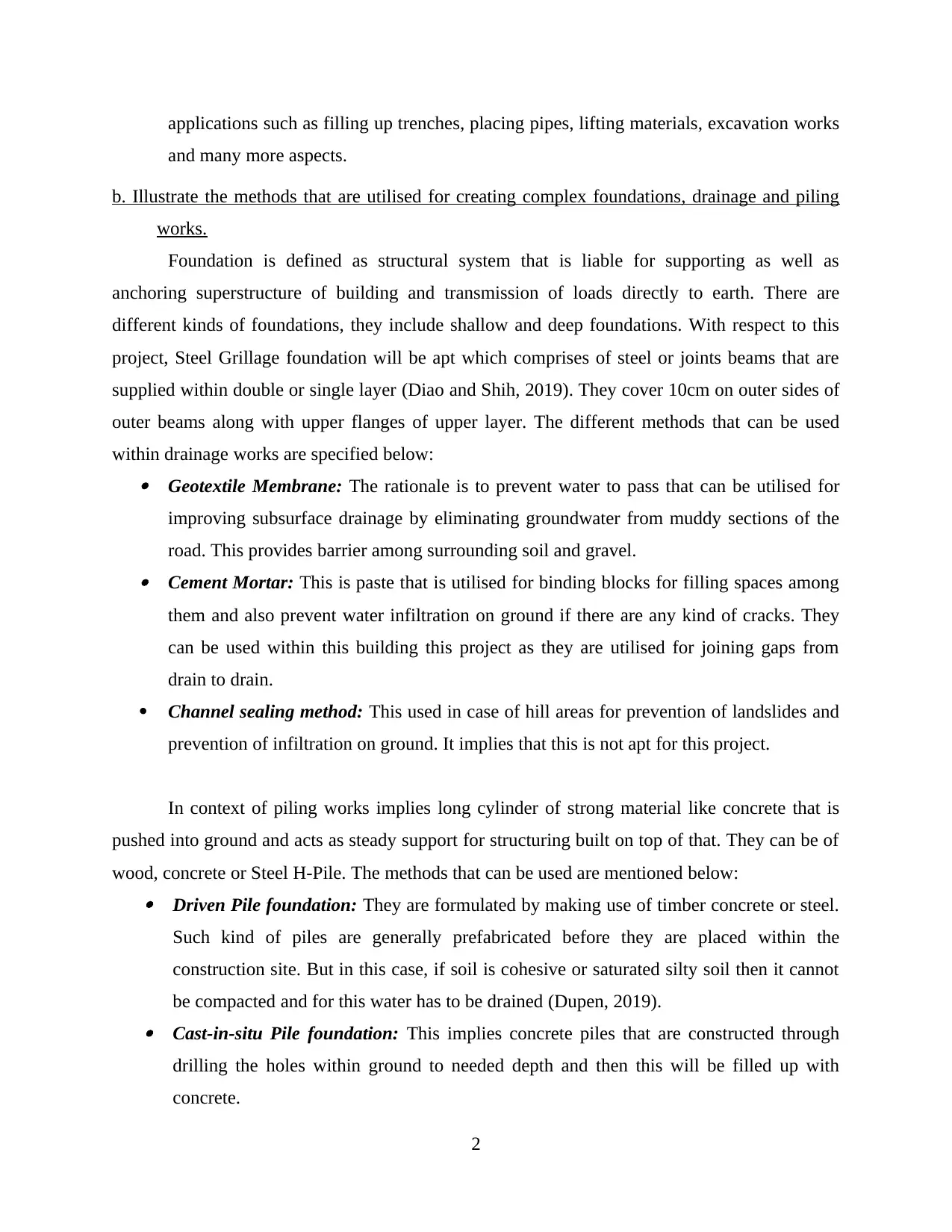
applications such as filling up trenches, placing pipes, lifting materials, excavation works
and many more aspects.
b. Illustrate the methods that are utilised for creating complex foundations, drainage and piling
works.
Foundation is defined as structural system that is liable for supporting as well as
anchoring superstructure of building and transmission of loads directly to earth. There are
different kinds of foundations, they include shallow and deep foundations. With respect to this
project, Steel Grillage foundation will be apt which comprises of steel or joints beams that are
supplied within double or single layer (Diao and Shih, 2019). They cover 10cm on outer sides of
outer beams along with upper flanges of upper layer. The different methods that can be used
within drainage works are specified below: Geotextile Membrane: The rationale is to prevent water to pass that can be utilised for
improving subsurface drainage by eliminating groundwater from muddy sections of the
road. This provides barrier among surrounding soil and gravel. Cement Mortar: This is paste that is utilised for binding blocks for filling spaces among
them and also prevent water infiltration on ground if there are any kind of cracks. They
can be used within this building this project as they are utilised for joining gaps from
drain to drain.
Channel sealing method: This used in case of hill areas for prevention of landslides and
prevention of infiltration on ground. It implies that this is not apt for this project.
In context of piling works implies long cylinder of strong material like concrete that is
pushed into ground and acts as steady support for structuring built on top of that. They can be of
wood, concrete or Steel H-Pile. The methods that can be used are mentioned below: Driven Pile foundation: They are formulated by making use of timber concrete or steel.
Such kind of piles are generally prefabricated before they are placed within the
construction site. But in this case, if soil is cohesive or saturated silty soil then it cannot
be compacted and for this water has to be drained (Dupen, 2019). Cast-in-situ Pile foundation: This implies concrete piles that are constructed through
drilling the holes within ground to needed depth and then this will be filled up with
concrete.
2
and many more aspects.
b. Illustrate the methods that are utilised for creating complex foundations, drainage and piling
works.
Foundation is defined as structural system that is liable for supporting as well as
anchoring superstructure of building and transmission of loads directly to earth. There are
different kinds of foundations, they include shallow and deep foundations. With respect to this
project, Steel Grillage foundation will be apt which comprises of steel or joints beams that are
supplied within double or single layer (Diao and Shih, 2019). They cover 10cm on outer sides of
outer beams along with upper flanges of upper layer. The different methods that can be used
within drainage works are specified below: Geotextile Membrane: The rationale is to prevent water to pass that can be utilised for
improving subsurface drainage by eliminating groundwater from muddy sections of the
road. This provides barrier among surrounding soil and gravel. Cement Mortar: This is paste that is utilised for binding blocks for filling spaces among
them and also prevent water infiltration on ground if there are any kind of cracks. They
can be used within this building this project as they are utilised for joining gaps from
drain to drain.
Channel sealing method: This used in case of hill areas for prevention of landslides and
prevention of infiltration on ground. It implies that this is not apt for this project.
In context of piling works implies long cylinder of strong material like concrete that is
pushed into ground and acts as steady support for structuring built on top of that. They can be of
wood, concrete or Steel H-Pile. The methods that can be used are mentioned below: Driven Pile foundation: They are formulated by making use of timber concrete or steel.
Such kind of piles are generally prefabricated before they are placed within the
construction site. But in this case, if soil is cohesive or saturated silty soil then it cannot
be compacted and for this water has to be drained (Dupen, 2019). Cast-in-situ Pile foundation: This implies concrete piles that are constructed through
drilling the holes within ground to needed depth and then this will be filled up with
concrete.
2
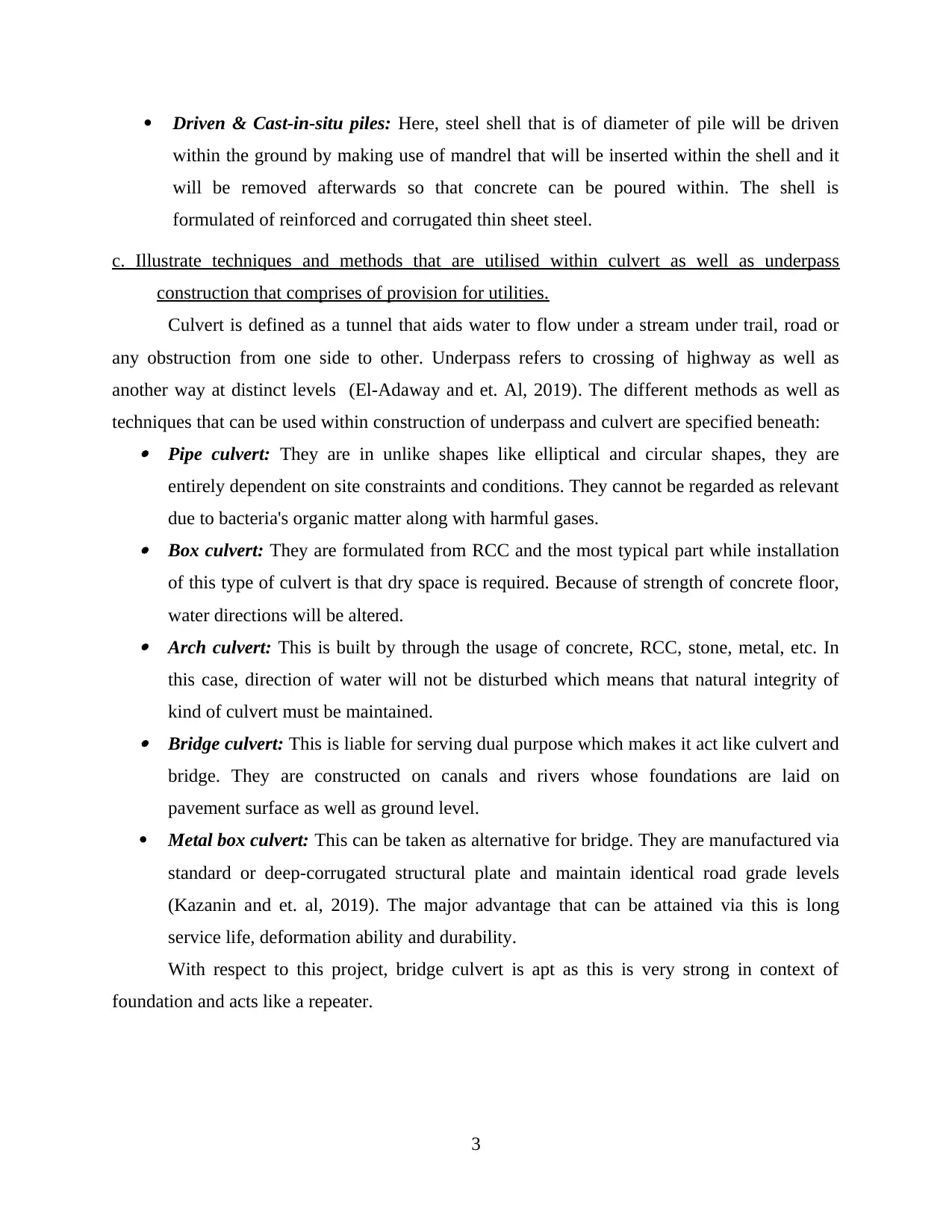
Driven & Cast-in-situ piles: Here, steel shell that is of diameter of pile will be driven
within the ground by making use of mandrel that will be inserted within the shell and it
will be removed afterwards so that concrete can be poured within. The shell is
formulated of reinforced and corrugated thin sheet steel.
c. Illustrate techniques and methods that are utilised within culvert as well as underpass
construction that comprises of provision for utilities.
Culvert is defined as a tunnel that aids water to flow under a stream under trail, road or
any obstruction from one side to other. Underpass refers to crossing of highway as well as
another way at distinct levels (El-Adaway and et. Al, 2019). The different methods as well as
techniques that can be used within construction of underpass and culvert are specified beneath: Pipe culvert: They are in unlike shapes like elliptical and circular shapes, they are
entirely dependent on site constraints and conditions. They cannot be regarded as relevant
due to bacteria's organic matter along with harmful gases. Box culvert: They are formulated from RCC and the most typical part while installation
of this type of culvert is that dry space is required. Because of strength of concrete floor,
water directions will be altered. Arch culvert: This is built by through the usage of concrete, RCC, stone, metal, etc. In
this case, direction of water will not be disturbed which means that natural integrity of
kind of culvert must be maintained. Bridge culvert: This is liable for serving dual purpose which makes it act like culvert and
bridge. They are constructed on canals and rivers whose foundations are laid on
pavement surface as well as ground level.
Metal box culvert: This can be taken as alternative for bridge. They are manufactured via
standard or deep-corrugated structural plate and maintain identical road grade levels
(Kazanin and et. al, 2019). The major advantage that can be attained via this is long
service life, deformation ability and durability.
With respect to this project, bridge culvert is apt as this is very strong in context of
foundation and acts like a repeater.
3
within the ground by making use of mandrel that will be inserted within the shell and it
will be removed afterwards so that concrete can be poured within. The shell is
formulated of reinforced and corrugated thin sheet steel.
c. Illustrate techniques and methods that are utilised within culvert as well as underpass
construction that comprises of provision for utilities.
Culvert is defined as a tunnel that aids water to flow under a stream under trail, road or
any obstruction from one side to other. Underpass refers to crossing of highway as well as
another way at distinct levels (El-Adaway and et. Al, 2019). The different methods as well as
techniques that can be used within construction of underpass and culvert are specified beneath: Pipe culvert: They are in unlike shapes like elliptical and circular shapes, they are
entirely dependent on site constraints and conditions. They cannot be regarded as relevant
due to bacteria's organic matter along with harmful gases. Box culvert: They are formulated from RCC and the most typical part while installation
of this type of culvert is that dry space is required. Because of strength of concrete floor,
water directions will be altered. Arch culvert: This is built by through the usage of concrete, RCC, stone, metal, etc. In
this case, direction of water will not be disturbed which means that natural integrity of
kind of culvert must be maintained. Bridge culvert: This is liable for serving dual purpose which makes it act like culvert and
bridge. They are constructed on canals and rivers whose foundations are laid on
pavement surface as well as ground level.
Metal box culvert: This can be taken as alternative for bridge. They are manufactured via
standard or deep-corrugated structural plate and maintain identical road grade levels
(Kazanin and et. al, 2019). The major advantage that can be attained via this is long
service life, deformation ability and durability.
With respect to this project, bridge culvert is apt as this is very strong in context of
foundation and acts like a repeater.
3
⊘ This is a preview!⊘
Do you want full access?
Subscribe today to unlock all pages.

Trusted by 1+ million students worldwide

d. Analyse methods along with techniques that can be utilised within deep excavation along with
complex & large earth moving operations.
Deep excavation refers to work that involves removing rocks or soil from site to form
hole, cavity or hole by making use of tools, explosives or machinery. Excavation comprises of
potholing, pit excavation, shafts, drives, trenches & retaining walls. There are different
techniques as well as methods that are utilised within this, they are specified beneath: Dumpling method: This is utilised when streets or buildings are within proximity. The
methods are utilised within constructing series of retaining walls within the trench,
around site parameter, section by section, leaving a centre referred to dumpling (Li and
et. al, 2019). Diaphragm walling: It is used for constructing R.C. retaining wall and area of work. IN
this mechanical excavation is used for reaching a depth. The sequence of work involves:
construction of guide wall, excavation for diaphragm wall, support by using bentonite
slurry and inert reinforcement and concreting.
Using cofferdams: It implies temporary box structure which is constructed on water or
earth that excludes water or soil from construction area. Here, sheet pile or double skin
cofferdam can be used.
e. Evaluation of methods and techniques that are used within dealing with slope as well as
ground stability for slopes that are unstable in vicinity of industrial parking area.
While construction, it is necessary to make sure that stability of slopes is improvised so
that effective base can be attained. This can be done by flattening of slopes that will lead to
minimise weight, soil stabilisation, furnishing lateral support by retaining walls or piles, cement
injections or grouting within special places and consolidation through electro osmosis that will
lead to further enhance stability (Monaldo, Nerilli and Vairo, 2019). The methods for attaining
slope and ground stability are specified beneath: Lorimer's method:This implies technique that is utilised for evaluation of slope stability
within the cohesive soils. Spencer's method: In this case computer programs that have cyclic algorithms are
needed which will make it easy to carry out slope stability analysis. Spencer's algorithm
is liable for satisfying equilibria on each slice.
4
complex & large earth moving operations.
Deep excavation refers to work that involves removing rocks or soil from site to form
hole, cavity or hole by making use of tools, explosives or machinery. Excavation comprises of
potholing, pit excavation, shafts, drives, trenches & retaining walls. There are different
techniques as well as methods that are utilised within this, they are specified beneath: Dumpling method: This is utilised when streets or buildings are within proximity. The
methods are utilised within constructing series of retaining walls within the trench,
around site parameter, section by section, leaving a centre referred to dumpling (Li and
et. al, 2019). Diaphragm walling: It is used for constructing R.C. retaining wall and area of work. IN
this mechanical excavation is used for reaching a depth. The sequence of work involves:
construction of guide wall, excavation for diaphragm wall, support by using bentonite
slurry and inert reinforcement and concreting.
Using cofferdams: It implies temporary box structure which is constructed on water or
earth that excludes water or soil from construction area. Here, sheet pile or double skin
cofferdam can be used.
e. Evaluation of methods and techniques that are used within dealing with slope as well as
ground stability for slopes that are unstable in vicinity of industrial parking area.
While construction, it is necessary to make sure that stability of slopes is improvised so
that effective base can be attained. This can be done by flattening of slopes that will lead to
minimise weight, soil stabilisation, furnishing lateral support by retaining walls or piles, cement
injections or grouting within special places and consolidation through electro osmosis that will
lead to further enhance stability (Monaldo, Nerilli and Vairo, 2019). The methods for attaining
slope and ground stability are specified beneath: Lorimer's method:This implies technique that is utilised for evaluation of slope stability
within the cohesive soils. Spencer's method: In this case computer programs that have cyclic algorithms are
needed which will make it easy to carry out slope stability analysis. Spencer's algorithm
is liable for satisfying equilibria on each slice.
4
Paraphrase This Document
Need a fresh take? Get an instant paraphrase of this document with our AI Paraphraser
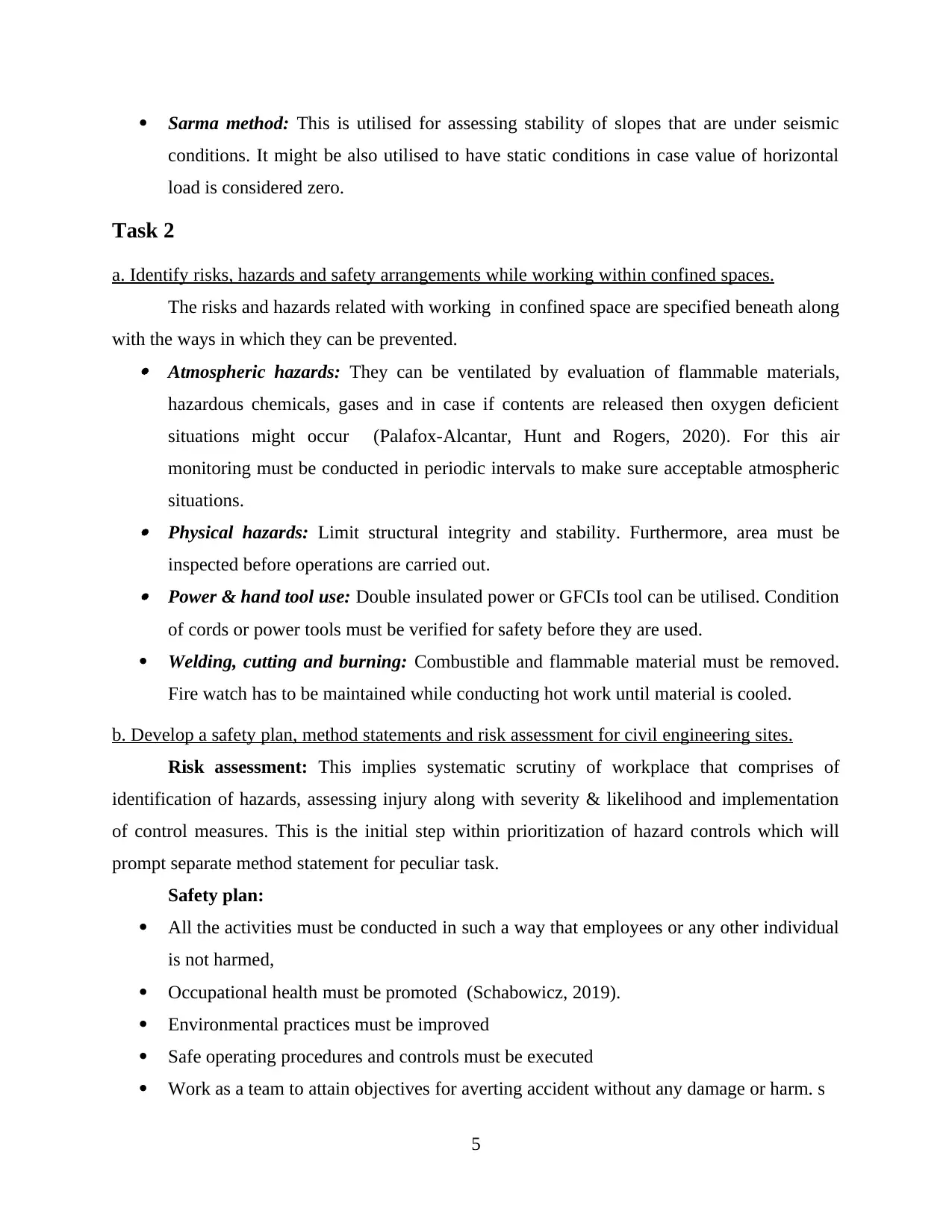
Sarma method: This is utilised for assessing stability of slopes that are under seismic
conditions. It might be also utilised to have static conditions in case value of horizontal
load is considered zero.
Task 2
a. Identify risks, hazards and safety arrangements while working within confined spaces.
The risks and hazards related with working in confined space are specified beneath along
with the ways in which they can be prevented. Atmospheric hazards: They can be ventilated by evaluation of flammable materials,
hazardous chemicals, gases and in case if contents are released then oxygen deficient
situations might occur (Palafox-Alcantar, Hunt and Rogers, 2020). For this air
monitoring must be conducted in periodic intervals to make sure acceptable atmospheric
situations. Physical hazards: Limit structural integrity and stability. Furthermore, area must be
inspected before operations are carried out. Power & hand tool use: Double insulated power or GFCIs tool can be utilised. Condition
of cords or power tools must be verified for safety before they are used.
Welding, cutting and burning: Combustible and flammable material must be removed.
Fire watch has to be maintained while conducting hot work until material is cooled.
b. Develop a safety plan, method statements and risk assessment for civil engineering sites.
Risk assessment: This implies systematic scrutiny of workplace that comprises of
identification of hazards, assessing injury along with severity & likelihood and implementation
of control measures. This is the initial step within prioritization of hazard controls which will
prompt separate method statement for peculiar task.
Safety plan:
All the activities must be conducted in such a way that employees or any other individual
is not harmed,
Occupational health must be promoted (Schabowicz, 2019).
Environmental practices must be improved
Safe operating procedures and controls must be executed
Work as a team to attain objectives for averting accident without any damage or harm. s
5
conditions. It might be also utilised to have static conditions in case value of horizontal
load is considered zero.
Task 2
a. Identify risks, hazards and safety arrangements while working within confined spaces.
The risks and hazards related with working in confined space are specified beneath along
with the ways in which they can be prevented. Atmospheric hazards: They can be ventilated by evaluation of flammable materials,
hazardous chemicals, gases and in case if contents are released then oxygen deficient
situations might occur (Palafox-Alcantar, Hunt and Rogers, 2020). For this air
monitoring must be conducted in periodic intervals to make sure acceptable atmospheric
situations. Physical hazards: Limit structural integrity and stability. Furthermore, area must be
inspected before operations are carried out. Power & hand tool use: Double insulated power or GFCIs tool can be utilised. Condition
of cords or power tools must be verified for safety before they are used.
Welding, cutting and burning: Combustible and flammable material must be removed.
Fire watch has to be maintained while conducting hot work until material is cooled.
b. Develop a safety plan, method statements and risk assessment for civil engineering sites.
Risk assessment: This implies systematic scrutiny of workplace that comprises of
identification of hazards, assessing injury along with severity & likelihood and implementation
of control measures. This is the initial step within prioritization of hazard controls which will
prompt separate method statement for peculiar task.
Safety plan:
All the activities must be conducted in such a way that employees or any other individual
is not harmed,
Occupational health must be promoted (Schabowicz, 2019).
Environmental practices must be improved
Safe operating procedures and controls must be executed
Work as a team to attain objectives for averting accident without any damage or harm. s
5

Method statements are utilised within construction like a means to control peculiar
health & safety risks which have been identified like installation of equipments, lifting activities,
dismantling, etc. Operators or mechanics are run over or caught in equipment when the brakes
aren't set, equipment is left in gear, wheel chocks are not used, or the equipment.
All the equipments required for job must be loaded and vehicle safety checks must be
carried out. Convey to site foreman for having permit for work.
Utilise personal protective equipments and inform all contractors for the same. Make sure
that area on which work is conducted their exit points do not have any kind of obstruction
(Wang, Xiang and Jiang, 2019).
Safe access along with egress must be maintained and site plans related with existent
ground has to be located and underground services must also be determined.
Area that will be excavated must be cleared by Golpla plastic grid and excavations will
not undermine any nearby structures.
c. Discuss codes of practice and health & safety legislations associated with civil engineering
sites in construction of industrial complex.
The health and safety legislations in context of construction are mentioned below:
Provision & use of work equipment regulations, 1998
Manual handling operations regulations 1992
Management of health and safety at work regulations 1999
Health and safety (display screen equipment) regulations 1992
Working at height regulations, 2015
The lifting operations & lifting equipment regulation, 1998
The construction (design & management) regulations, 2015
Code of practice,
Permitted hours for work as per Control of Pollution Act, 1974
Damage caused by work, party wall agreement must be maintained and council is not
empowered for this (Zavadskas, Bausys and Antucheviciene, 2019).
Site safety, any issues related with unsafe processes must be referred to health & safety
executives.
6
health & safety risks which have been identified like installation of equipments, lifting activities,
dismantling, etc. Operators or mechanics are run over or caught in equipment when the brakes
aren't set, equipment is left in gear, wheel chocks are not used, or the equipment.
All the equipments required for job must be loaded and vehicle safety checks must be
carried out. Convey to site foreman for having permit for work.
Utilise personal protective equipments and inform all contractors for the same. Make sure
that area on which work is conducted their exit points do not have any kind of obstruction
(Wang, Xiang and Jiang, 2019).
Safe access along with egress must be maintained and site plans related with existent
ground has to be located and underground services must also be determined.
Area that will be excavated must be cleared by Golpla plastic grid and excavations will
not undermine any nearby structures.
c. Discuss codes of practice and health & safety legislations associated with civil engineering
sites in construction of industrial complex.
The health and safety legislations in context of construction are mentioned below:
Provision & use of work equipment regulations, 1998
Manual handling operations regulations 1992
Management of health and safety at work regulations 1999
Health and safety (display screen equipment) regulations 1992
Working at height regulations, 2015
The lifting operations & lifting equipment regulation, 1998
The construction (design & management) regulations, 2015
Code of practice,
Permitted hours for work as per Control of Pollution Act, 1974
Damage caused by work, party wall agreement must be maintained and council is not
empowered for this (Zavadskas, Bausys and Antucheviciene, 2019).
Site safety, any issues related with unsafe processes must be referred to health & safety
executives.
6
⊘ This is a preview!⊘
Do you want full access?
Subscribe today to unlock all pages.

Trusted by 1+ million students worldwide
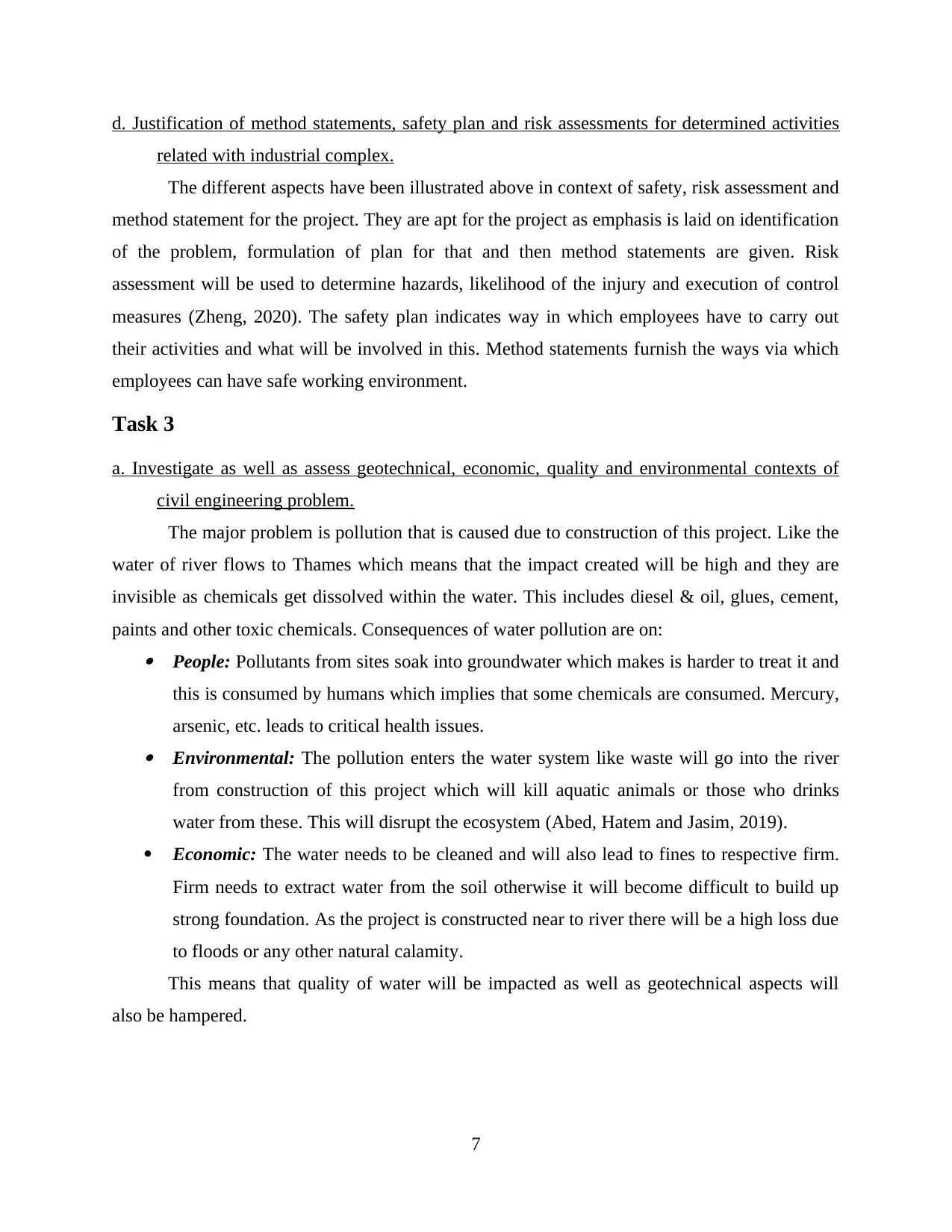
d. Justification of method statements, safety plan and risk assessments for determined activities
related with industrial complex.
The different aspects have been illustrated above in context of safety, risk assessment and
method statement for the project. They are apt for the project as emphasis is laid on identification
of the problem, formulation of plan for that and then method statements are given. Risk
assessment will be used to determine hazards, likelihood of the injury and execution of control
measures (Zheng, 2020). The safety plan indicates way in which employees have to carry out
their activities and what will be involved in this. Method statements furnish the ways via which
employees can have safe working environment.
Task 3
a. Investigate as well as assess geotechnical, economic, quality and environmental contexts of
civil engineering problem.
The major problem is pollution that is caused due to construction of this project. Like the
water of river flows to Thames which means that the impact created will be high and they are
invisible as chemicals get dissolved within the water. This includes diesel & oil, glues, cement,
paints and other toxic chemicals. Consequences of water pollution are on: People: Pollutants from sites soak into groundwater which makes is harder to treat it and
this is consumed by humans which implies that some chemicals are consumed. Mercury,
arsenic, etc. leads to critical health issues. Environmental: The pollution enters the water system like waste will go into the river
from construction of this project which will kill aquatic animals or those who drinks
water from these. This will disrupt the ecosystem (Abed, Hatem and Jasim, 2019).
Economic: The water needs to be cleaned and will also lead to fines to respective firm.
Firm needs to extract water from the soil otherwise it will become difficult to build up
strong foundation. As the project is constructed near to river there will be a high loss due
to floods or any other natural calamity.
This means that quality of water will be impacted as well as geotechnical aspects will
also be hampered.
7
related with industrial complex.
The different aspects have been illustrated above in context of safety, risk assessment and
method statement for the project. They are apt for the project as emphasis is laid on identification
of the problem, formulation of plan for that and then method statements are given. Risk
assessment will be used to determine hazards, likelihood of the injury and execution of control
measures (Zheng, 2020). The safety plan indicates way in which employees have to carry out
their activities and what will be involved in this. Method statements furnish the ways via which
employees can have safe working environment.
Task 3
a. Investigate as well as assess geotechnical, economic, quality and environmental contexts of
civil engineering problem.
The major problem is pollution that is caused due to construction of this project. Like the
water of river flows to Thames which means that the impact created will be high and they are
invisible as chemicals get dissolved within the water. This includes diesel & oil, glues, cement,
paints and other toxic chemicals. Consequences of water pollution are on: People: Pollutants from sites soak into groundwater which makes is harder to treat it and
this is consumed by humans which implies that some chemicals are consumed. Mercury,
arsenic, etc. leads to critical health issues. Environmental: The pollution enters the water system like waste will go into the river
from construction of this project which will kill aquatic animals or those who drinks
water from these. This will disrupt the ecosystem (Abed, Hatem and Jasim, 2019).
Economic: The water needs to be cleaned and will also lead to fines to respective firm.
Firm needs to extract water from the soil otherwise it will become difficult to build up
strong foundation. As the project is constructed near to river there will be a high loss due
to floods or any other natural calamity.
This means that quality of water will be impacted as well as geotechnical aspects will
also be hampered.
7
Paraphrase This Document
Need a fresh take? Get an instant paraphrase of this document with our AI Paraphraser

b. Formulate proposal that illustrates quality, economic, geotechnical and environmental aspects
illustrated in above section will be addressed.
The measures that can be taken up for dealing with water pollution so that quality of
water can be maintained and geotechnical aspects will be handled are specified beneath: Monitoring & improving management as well as disposal of site waste for ensuring that
waste is handled in adequate manner and stopped from spreading. Keep materials like cement or sand secured, materials must be stored in a manner that
the risk of washed into drains or waterways can be prevented. Cover all drains for preventing waste from getting into water (Bheel and et. al, 2019). Keep footpath & road to site clean all times as this will lead to prevention of silt along
with other pollutants from running into water bodies.
Gather & treat waste-water that is being produced.
Task 4
a. Furnish methods and techniques that are utilised within highway designing as well as
development of proposal for new infrastructure.
The methods that can be used are: geometric design, flexible pavement design, rigid
pavement design, flexible pavement overlay, rigid pavement overlay design and drainage system
design (Diao and Shih, 2019). They can be used as per the requirement of project as each have
different usage. The proposal for infrastructure is illustrated below:
Project: Construction of 10 industrial buildings and factories
Scope: Provide economic options for people across the country and provide individuals to have
different items at one place.
Stakeholders: Employees, management, Board of directors, shareholders and people
Construction amount: The overall cost for constructing this project will around $750 billion.
All the activities that will be carried out while carrying out construction is that all the rules &
regulations formulated by Government will be adhered and health & safety of employees
working as well as people surrounding the site will be ensured. All the environmental aspects
will be taken into consideration so that any kind of pollution (water, air or sound) do not takes
place.
8
illustrated in above section will be addressed.
The measures that can be taken up for dealing with water pollution so that quality of
water can be maintained and geotechnical aspects will be handled are specified beneath: Monitoring & improving management as well as disposal of site waste for ensuring that
waste is handled in adequate manner and stopped from spreading. Keep materials like cement or sand secured, materials must be stored in a manner that
the risk of washed into drains or waterways can be prevented. Cover all drains for preventing waste from getting into water (Bheel and et. al, 2019). Keep footpath & road to site clean all times as this will lead to prevention of silt along
with other pollutants from running into water bodies.
Gather & treat waste-water that is being produced.
Task 4
a. Furnish methods and techniques that are utilised within highway designing as well as
development of proposal for new infrastructure.
The methods that can be used are: geometric design, flexible pavement design, rigid
pavement design, flexible pavement overlay, rigid pavement overlay design and drainage system
design (Diao and Shih, 2019). They can be used as per the requirement of project as each have
different usage. The proposal for infrastructure is illustrated below:
Project: Construction of 10 industrial buildings and factories
Scope: Provide economic options for people across the country and provide individuals to have
different items at one place.
Stakeholders: Employees, management, Board of directors, shareholders and people
Construction amount: The overall cost for constructing this project will around $750 billion.
All the activities that will be carried out while carrying out construction is that all the rules &
regulations formulated by Government will be adhered and health & safety of employees
working as well as people surrounding the site will be ensured. All the environmental aspects
will be taken into consideration so that any kind of pollution (water, air or sound) do not takes
place.
8
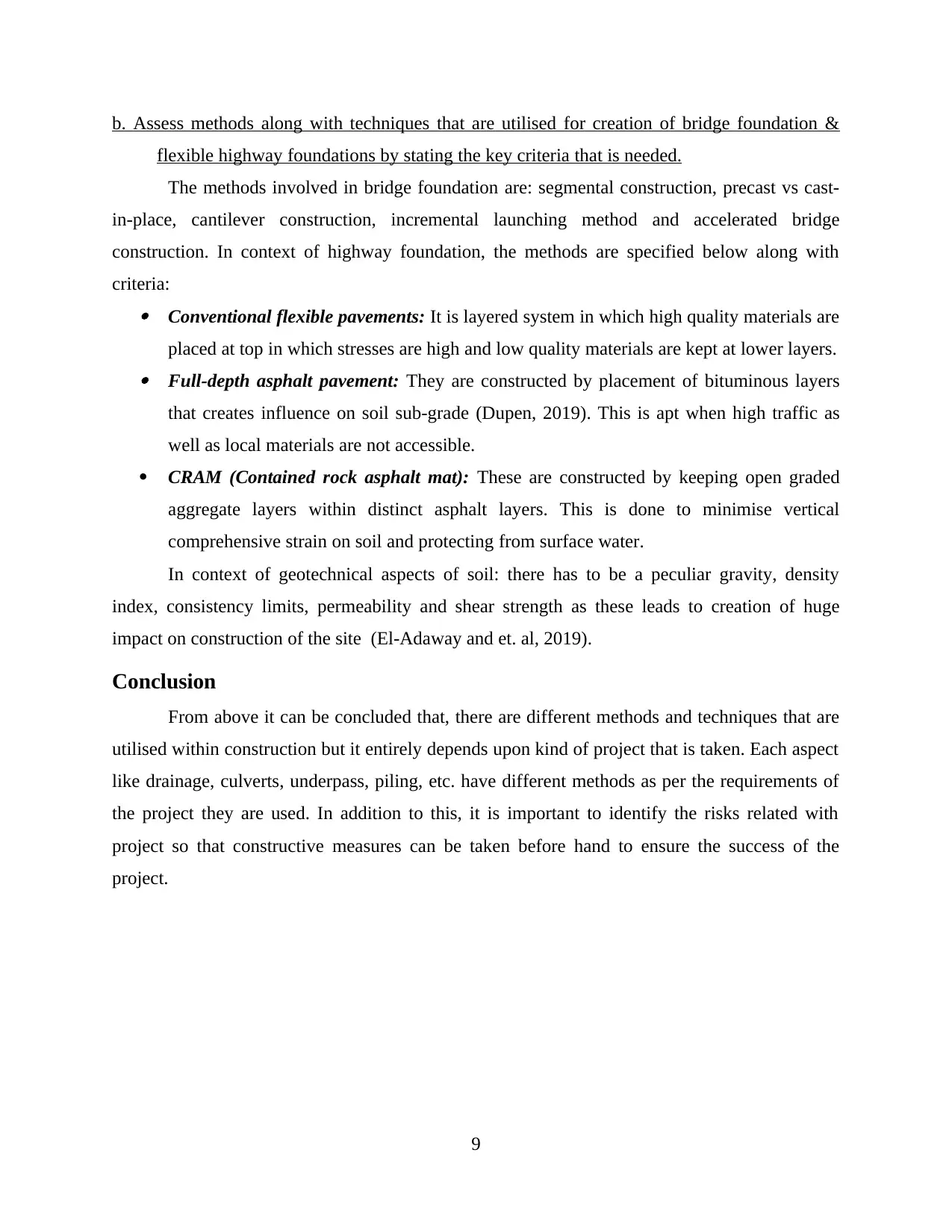
b. Assess methods along with techniques that are utilised for creation of bridge foundation &
flexible highway foundations by stating the key criteria that is needed.
The methods involved in bridge foundation are: segmental construction, precast vs cast-
in-place, cantilever construction, incremental launching method and accelerated bridge
construction. In context of highway foundation, the methods are specified below along with
criteria: Conventional flexible pavements: It is layered system in which high quality materials are
placed at top in which stresses are high and low quality materials are kept at lower layers. Full-depth asphalt pavement: They are constructed by placement of bituminous layers
that creates influence on soil sub-grade (Dupen, 2019). This is apt when high traffic as
well as local materials are not accessible.
CRAM (Contained rock asphalt mat): These are constructed by keeping open graded
aggregate layers within distinct asphalt layers. This is done to minimise vertical
comprehensive strain on soil and protecting from surface water.
In context of geotechnical aspects of soil: there has to be a peculiar gravity, density
index, consistency limits, permeability and shear strength as these leads to creation of huge
impact on construction of the site (El-Adaway and et. al, 2019).
Conclusion
From above it can be concluded that, there are different methods and techniques that are
utilised within construction but it entirely depends upon kind of project that is taken. Each aspect
like drainage, culverts, underpass, piling, etc. have different methods as per the requirements of
the project they are used. In addition to this, it is important to identify the risks related with
project so that constructive measures can be taken before hand to ensure the success of the
project.
9
flexible highway foundations by stating the key criteria that is needed.
The methods involved in bridge foundation are: segmental construction, precast vs cast-
in-place, cantilever construction, incremental launching method and accelerated bridge
construction. In context of highway foundation, the methods are specified below along with
criteria: Conventional flexible pavements: It is layered system in which high quality materials are
placed at top in which stresses are high and low quality materials are kept at lower layers. Full-depth asphalt pavement: They are constructed by placement of bituminous layers
that creates influence on soil sub-grade (Dupen, 2019). This is apt when high traffic as
well as local materials are not accessible.
CRAM (Contained rock asphalt mat): These are constructed by keeping open graded
aggregate layers within distinct asphalt layers. This is done to minimise vertical
comprehensive strain on soil and protecting from surface water.
In context of geotechnical aspects of soil: there has to be a peculiar gravity, density
index, consistency limits, permeability and shear strength as these leads to creation of huge
impact on construction of the site (El-Adaway and et. al, 2019).
Conclusion
From above it can be concluded that, there are different methods and techniques that are
utilised within construction but it entirely depends upon kind of project that is taken. Each aspect
like drainage, culverts, underpass, piling, etc. have different methods as per the requirements of
the project they are used. In addition to this, it is important to identify the risks related with
project so that constructive measures can be taken before hand to ensure the success of the
project.
9
⊘ This is a preview!⊘
Do you want full access?
Subscribe today to unlock all pages.

Trusted by 1+ million students worldwide

References
Books & Journals
Abed, H.R., Hatem, W.A. and Jasim, N.A., 2019. Adopting BIM technology in fall prevention
plans. Civil Engineering Journal, 5(10), pp.2270-2281.
Bheel, N. and et. al, 2019. Use of rice husk ash as cementitious material in concrete.
Engineering, Technology & Applied Science Research, 9(3), pp.4209-4212.
Diao, P.H. and Shih, N.J., 2019. Trends and research issues of augmented reality studies in
architectural and civil engineering education—A review of academic journal
publications. Applied Sciences, 9(9), p.1840.
Dupen, B., 2019. Applied strength of materials for engineering technology. School of
Polytechnic, Purdue University Fort Wayne.
El-Adaway, I.H. And et. al, 2019. Analytic overview of citation metrics in the civil engineering
domain with focus on construction engineering and management specialty area and its
subdisciplines. Journal of Construction Engineering and Management, 145(10),
p.04019060.
Kazanin, O.I. And et. al, 2019. Improvement of a longwall recovery room erection technology.
International Journal of Civil Engineering and Technology (IJCIET) Volume, 10,
pp.1148-1153.
Li, P. and et. al, 2019. Research on dust suppression technology of shotcrete based on new spray
equipment and process optimization. Advances in Civil Engineering, 2019.
Monaldo, E., Nerilli, F. and Vairo, G., 2019. Basalt-based fiber-reinforced materials and
structural applications in civil engineering. Composite Structures, 214, pp.246-263.
Palafox-Alcantar, P.G., Hunt, D.V.L. and Rogers, C.D.F., 2020. The complementary use of game
theory for the circular economy: A review of waste management decision-making
methods in civil engineering. Waste Management, 102, pp.598-612.
Schabowicz, K., 2019. Non-destructive testing of materials in civil engineering.
Wang, H., Xiang, P. and Jiang, L., 2019. Strain transfer theory of industrialized optical fiber-
based sensors in civil engineering: A review on measurement accuracy, design and
calibration. Sensors and Actuators A: Physical, 285, pp.414-426.
Zavadskas, E.K., Bausys, R. and Antucheviciene, J., 2019. Civil engineering and symmetry.
Zheng, X., 2020. Research of Civil Engineering Construction Site Management Optimization
Strategy Based on Capability Spectrum Method. Academic Journal of Business &
Management, 2(2).
10
Books & Journals
Abed, H.R., Hatem, W.A. and Jasim, N.A., 2019. Adopting BIM technology in fall prevention
plans. Civil Engineering Journal, 5(10), pp.2270-2281.
Bheel, N. and et. al, 2019. Use of rice husk ash as cementitious material in concrete.
Engineering, Technology & Applied Science Research, 9(3), pp.4209-4212.
Diao, P.H. and Shih, N.J., 2019. Trends and research issues of augmented reality studies in
architectural and civil engineering education—A review of academic journal
publications. Applied Sciences, 9(9), p.1840.
Dupen, B., 2019. Applied strength of materials for engineering technology. School of
Polytechnic, Purdue University Fort Wayne.
El-Adaway, I.H. And et. al, 2019. Analytic overview of citation metrics in the civil engineering
domain with focus on construction engineering and management specialty area and its
subdisciplines. Journal of Construction Engineering and Management, 145(10),
p.04019060.
Kazanin, O.I. And et. al, 2019. Improvement of a longwall recovery room erection technology.
International Journal of Civil Engineering and Technology (IJCIET) Volume, 10,
pp.1148-1153.
Li, P. and et. al, 2019. Research on dust suppression technology of shotcrete based on new spray
equipment and process optimization. Advances in Civil Engineering, 2019.
Monaldo, E., Nerilli, F. and Vairo, G., 2019. Basalt-based fiber-reinforced materials and
structural applications in civil engineering. Composite Structures, 214, pp.246-263.
Palafox-Alcantar, P.G., Hunt, D.V.L. and Rogers, C.D.F., 2020. The complementary use of game
theory for the circular economy: A review of waste management decision-making
methods in civil engineering. Waste Management, 102, pp.598-612.
Schabowicz, K., 2019. Non-destructive testing of materials in civil engineering.
Wang, H., Xiang, P. and Jiang, L., 2019. Strain transfer theory of industrialized optical fiber-
based sensors in civil engineering: A review on measurement accuracy, design and
calibration. Sensors and Actuators A: Physical, 285, pp.414-426.
Zavadskas, E.K., Bausys, R. and Antucheviciene, J., 2019. Civil engineering and symmetry.
Zheng, X., 2020. Research of Civil Engineering Construction Site Management Optimization
Strategy Based on Capability Spectrum Method. Academic Journal of Business &
Management, 2(2).
10
1 out of 13
Related Documents
Your All-in-One AI-Powered Toolkit for Academic Success.
+13062052269
info@desklib.com
Available 24*7 on WhatsApp / Email
![[object Object]](/_next/static/media/star-bottom.7253800d.svg)
Unlock your academic potential
© 2024 | Zucol Services PVT LTD | All rights reserved.





